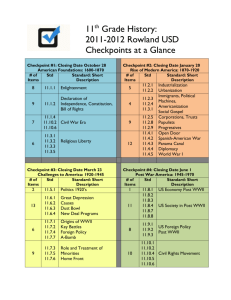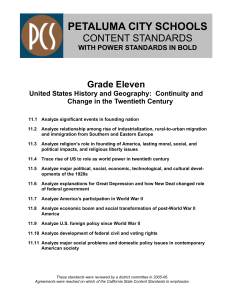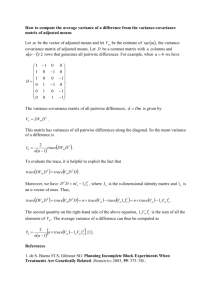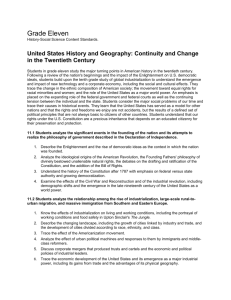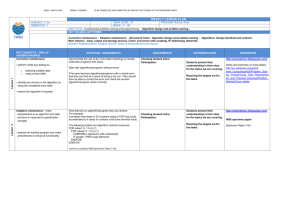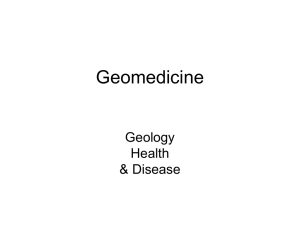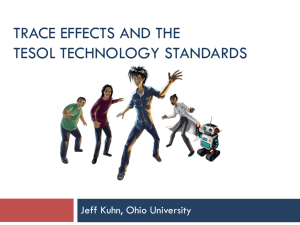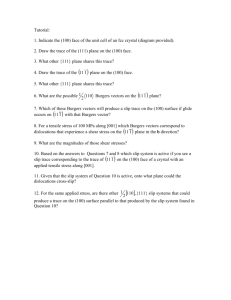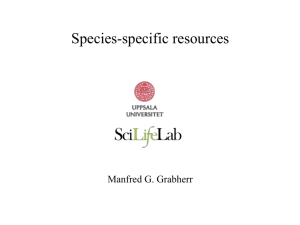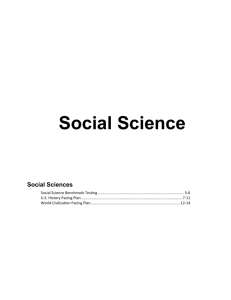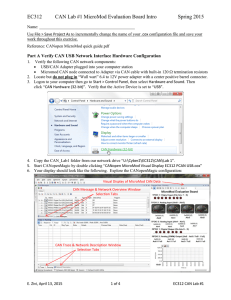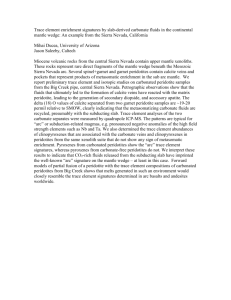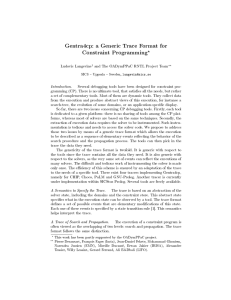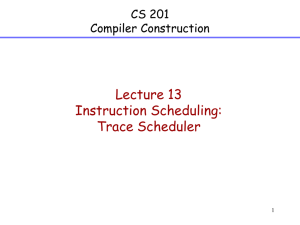Grade 9 Reading, Writing, and Written and Oral Expression Standards
advertisement
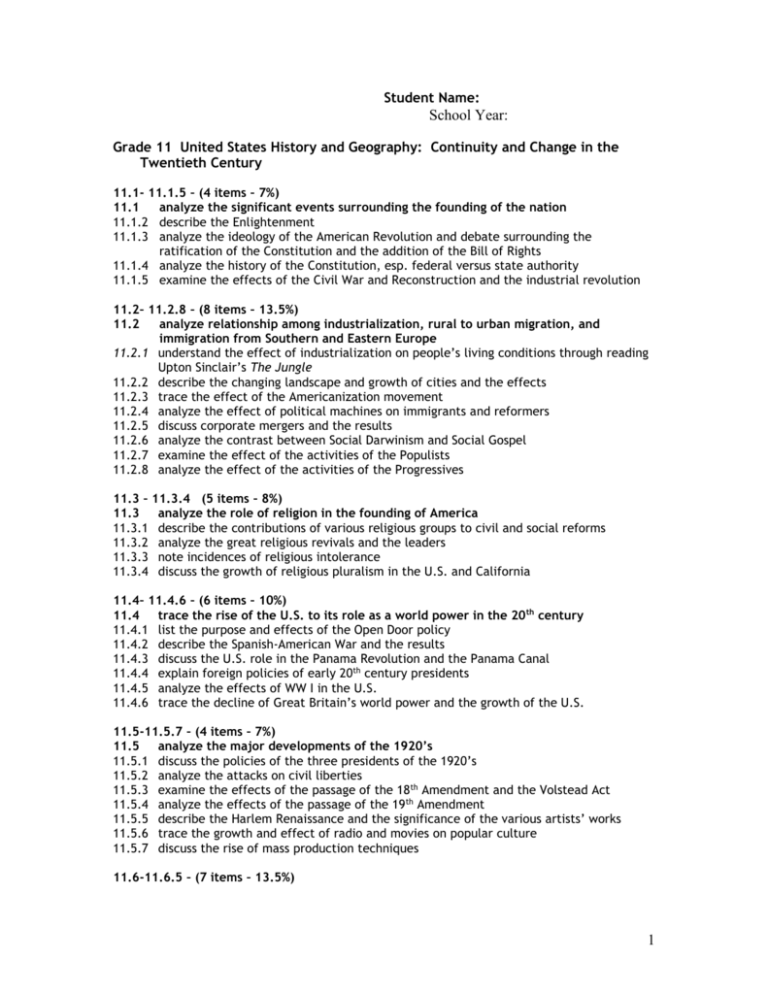
Student Name: School Year: Grade 11 United States History and Geography: Continuity and Change in the Twentieth Century 11.1- 11.1.5 – (4 items – 7%) 11.1 analyze the significant events surrounding the founding of the nation 11.1.2 describe the Enlightenment 11.1.3 analyze the ideology of the American Revolution and debate surrounding the ratification of the Constitution and the addition of the Bill of Rights 11.1.4 analyze the history of the Constitution, esp. federal versus state authority 11.1.5 examine the effects of the Civil War and Reconstruction and the industrial revolution 11.2– 11.2.8 – (8 items – 13.5%) 11.2 analyze relationship among industrialization, rural to urban migration, and immigration from Southern and Eastern Europe 11.2.1 understand the effect of industrialization on people’s living conditions through reading Upton Sinclair’s The Jungle 11.2.2 describe the changing landscape and growth of cities and the effects 11.2.3 trace the effect of the Americanization movement 11.2.4 analyze the effect of political machines on immigrants and reformers 11.2.5 discuss corporate mergers and the results 11.2.6 analyze the contrast between Social Darwinism and Social Gospel 11.2.7 examine the effect of the activities of the Populists 11.2.8 analyze the effect of the activities of the Progressives 11.3 – 11.3.4 (5 items – 8%) 11.3 analyze the role of religion in the founding of America 11.3.1 describe the contributions of various religious groups to civil and social reforms 11.3.2 analyze the great religious revivals and the leaders 11.3.3 note incidences of religious intolerance 11.3.4 discuss the growth of religious pluralism in the U.S. and California 11.4– 11.4.6 – (6 items – 10%) 11.4 trace the rise of the U.S. to its role as a world power in the 20 th century 11.4.1 list the purpose and effects of the Open Door policy 11.4.2 describe the Spanish-American War and the results 11.4.3 discuss the U.S. role in the Panama Revolution and the Panama Canal 11.4.4 explain foreign policies of early 20th century presidents 11.4.5 analyze the effects of WW I in the U.S. 11.4.6 trace the decline of Great Britain’s world power and the growth of the U.S. 11.5-11.5.7 – (4 items – 7%) 11.5 analyze the major developments of the 1920’s 11.5.1 discuss the policies of the three presidents of the 1920’s 11.5.2 analyze the attacks on civil liberties 11.5.3 examine the effects of the passage of the 18 th Amendment and the Volstead Act 11.5.4 analyze the effects of the passage of the 19th Amendment 11.5.5 describe the Harlem Renaissance and the significance of the various artists’ works 11.5.6 trace the growth and effect of radio and movies on popular culture 11.5.7 discuss the rise of mass production techniques 11.6-11.6.5 – (7 items – 13.5%) 1 11.6 11.6.1 11.6.2 11.6.3 11.6.4 11.6.5 analyze the explanations for the Great Depression and the changes in the role of the federal government because of the New Deal describe the economic issues that caused the creation of the Federal Reserve describe the steps taken by the Federal Reserve, Congress and the President to combat the economic crisis describe the human toll of the Great Depression, natural disasters and unwise farming practices analyze the effects of New Deal economic policies and expanded role of the federal government trace the history of organized labor 11.7-11.7.8 – (5 items – 8%) 11.7 analyze the American participation in WW II 11.7.1 examine the origins of American involvement 11.7.2 explain the U.S. and Allied wartime strategy and the major battles 11.7.3 identify the role and sacrifices of individual American soldiers 11.7.4 analyze Roosevelt’s foreign policies 11.7.5 discuss the Constitutional issues and impact of events on the U.S. home front (e.g., Japanese internment; restrictions of German and Italians; treatment of Jews) 11.7.6 describe major developments in aviation, weaponry, communication and industry 11.7.7 discuss the decision to drop atomic bombs and the consequences 11.7.8 analyze the effect of the Marshall Plan in Europe and in the U.S. 11.8-11.8.5 – (5 items – 8%) 11.8 analyze the economic boom and social transformation of post WW II U.S. 11.8.1 trace the growth of professional and white collar jobs 11.8.2 describe the significance of Mexican immigration esp. in California 11.8.3 examine Truman’s labor policy and congressional response 11.8.4 analyze new federal spending and the effects of the economic policies 11.8.5 describe the increased powers of the presidency 11.8.6 discuss the diversity of environmental regions in North America and the rise of environmental problems 11.8.7 describe the social effects of the growth of technology 11.8.8 discuss various regional forms of popular culture 11.9-11.9.7 – (6 items – 10%) 11.9 analyze U.S. foreign policy since WW II 11.9.1 discuss the establishment of world organizations, including the United Nation 11.9.2 discuss the role of NATO and SEATO 11.9.3 trace the origins and world consequences of the Cold War 11.9.4 list the effects of foreign policy on domestic policy and vice versa 11.9.5 analyze the role of the Reagan Administration in the victory of the Cold War 11.9.6 describe various factors in the Meddle East policy, including the Gulf War 11.9.7 examine the U.S. and Mexican relationship 11.10-11.10.7 – (5 items – 8%) 11.10 analyze the development of federal civil rights and voting rights 11.10.1 explain the effects of civil rights policies and the demands of African Americans on Roosevelt 11.10.2 examine the key events, policies and court cases of civil rights 11.10.3 describe the legal collaboration between African-Americans and white civil rights lawyers 11.10.4 examine the role of civil rights advocates 11.10.5 discuss the effect of the African-American civil rights movement on other movements 11.10.6 analyze the passage and effect of civil rights and voting rights legislation 2 11.10.7 analyze the growth and effect of the women’s movement 11.11-11.11.7 – (4 items – 7%) 11.11 analyze the major social problems and domestic policy issues in Contemporary American society 11.11.1 discuss the reasons for the nation’s changing immigration policy 11.11.2 discuss the significant domestic policy speeches of the presidents since WWII 11.11.3 describe the changing role of women and the consequences 11.11.4 explain the Watergate constitutional crisis 11.11.5 trace the effects of the environmental policies 11.11.6 analyze the effect of poverty on social policies 11.11.7 explain the responses of federal, state, and local government to population changes Analytical Skills in History and Social Sciences (15 items – 25%) 11.12 chronological and spatial thinking 11.12.1 compare the present and past and evaluate lessons learned 11.12.2 analyze the rate of change and its differences depending on events and locations 11.12.3 use a variety of maps and documents to interpret population changes 11.12.4 relate current events to the characteristics of places and regions 11.13 historical research, evidence, and point of view 11.13.1 distinguish valid from fallacious arguments in historical interpretations 11.13.2 identify bias and prejudice 11.13.3 evaluate major debates among historians 11.13.4 construct a research project in written and oral form 11.14 historical interpretation 11.14.1 connect particular events and larger social, economic and political trends 11.14.2 interpret past events within their own time periods 11.14.3 analyze an historical event that could have taken another direction 11.14.4 analyze human effect on geography and the environment 11.14.5analyze the historical behavior of the U.S. economy 3




